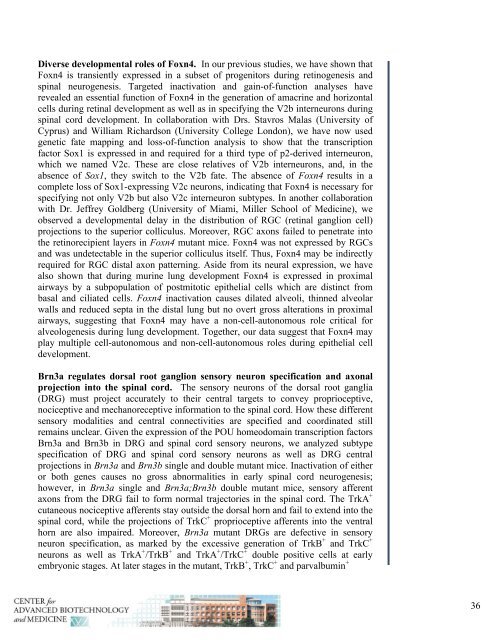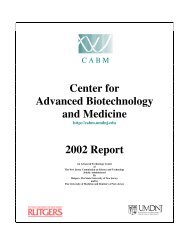Annual Report 2011 - Center for Advanced Biotechnology and ...
Annual Report 2011 - Center for Advanced Biotechnology and ...
Annual Report 2011 - Center for Advanced Biotechnology and ...
Create successful ePaper yourself
Turn your PDF publications into a flip-book with our unique Google optimized e-Paper software.
Diverse developmental roles of Foxn4. In our previous studies, we have shown that<br />
Foxn4 is transiently expressed in a subset of progenitors during retinogenesis <strong>and</strong><br />
spinal neurogenesis. Targeted inactivation <strong>and</strong> gain-of-function analyses have<br />
revealed an essential function of Foxn4 in the generation of amacrine <strong>and</strong> horizontal<br />
cells during retinal development as well as in specifying the V2b interneurons during<br />
spinal cord development. In collaboration with Drs. Stavros Malas (University of<br />
Cyprus) <strong>and</strong> William Richardson (University College London), we have now used<br />
genetic fate mapping <strong>and</strong> loss-of-function analysis to show that the transcription<br />
factor Sox1 is expressed in <strong>and</strong> required <strong>for</strong> a third type of p2-derived interneuron,<br />
which we named V2c. These are close relatives of V2b interneurons, <strong>and</strong>, in the<br />
absence of Sox1, they switch to the V2b fate. The absence of Foxn4 results in a<br />
complete loss of Sox1-expressing V2c neurons, indicating that Foxn4 is necessary <strong>for</strong><br />
specifying not only V2b but also V2c interneuron subtypes. In another collaboration<br />
with Dr. Jeffrey Goldberg (University of Miami, Miller School of Medicine), we<br />
observed a developmental delay in the distribution of RGC (retinal ganglion cell)<br />
projections to the superior colliculus. Moreover, RGC axons failed to penetrate into<br />
the retinorecipient layers in Foxn4 mutant mice. Foxn4 was not expressed by RGCs<br />
<strong>and</strong> was undetectable in the superior colliculus itself. Thus, Foxn4 may be indirectly<br />
required <strong>for</strong> RGC distal axon patterning. Aside from its neural expression, we have<br />
also shown that during murine lung development Foxn4 is expressed in proximal<br />
airways by a subpopulation of postmitotic epithelial cells which are distinct from<br />
basal <strong>and</strong> ciliated cells. Foxn4 inactivation causes dilated alveoli, thinned alveolar<br />
walls <strong>and</strong> reduced septa in the distal lung but no overt gross alterations in proximal<br />
airways, suggesting that Foxn4 may have a non-cell-autonomous role critical <strong>for</strong><br />
alveologenesis during lung development. Together, our data suggest that Foxn4 may<br />
play multiple cell-autonomous <strong>and</strong> non-cell-autonomous roles during epithelial cell<br />
development.<br />
Brn3a regulates dorsal root ganglion sensory neuron specification <strong>and</strong> axonal<br />
projection into the spinal cord. The sensory neurons of the dorsal root ganglia<br />
(DRG) must project accurately to their central targets to convey proprioceptive,<br />
nociceptive <strong>and</strong> mechanoreceptive in<strong>for</strong>mation to the spinal cord. How these different<br />
sensory modalities <strong>and</strong> central connectivities are specified <strong>and</strong> coordinated still<br />
remains unclear. Given the expression of the POU homeodomain transcription factors<br />
Brn3a <strong>and</strong> Brn3b in DRG <strong>and</strong> spinal cord sensory neurons, we analyzed subtype<br />
specification of DRG <strong>and</strong> spinal cord sensory neurons as well as DRG central<br />
projections in Brn3a <strong>and</strong> Brn3b single <strong>and</strong> double mutant mice. Inactivation of either<br />
or both genes causes no gross abnormalities in early spinal cord neurogenesis;<br />
however, in Brn3a single <strong>and</strong> Brn3a;Brn3b double mutant mice, sensory afferent<br />
axons from the DRG fail to <strong>for</strong>m normal trajectories in the spinal cord. The TrkA +<br />
cutaneous nociceptive afferents stay outside the dorsal horn <strong>and</strong> fail to extend into the<br />
spinal cord, while the projections of TrkC + proprioceptive afferents into the ventral<br />
horn are also impaired. Moreover, Brn3a mutant DRGs are defective in sensory<br />
neuron specification, as marked by the excessive generation of TrkB + <strong>and</strong> TrkC +<br />
neurons as well as TrkA + /TrkB + <strong>and</strong> TrkA + /TrkC + double positive cells at early<br />
embryonic stages. At later stages in the mutant, TrkB + , TrkC + <strong>and</strong> parvalbumin +<br />
36



